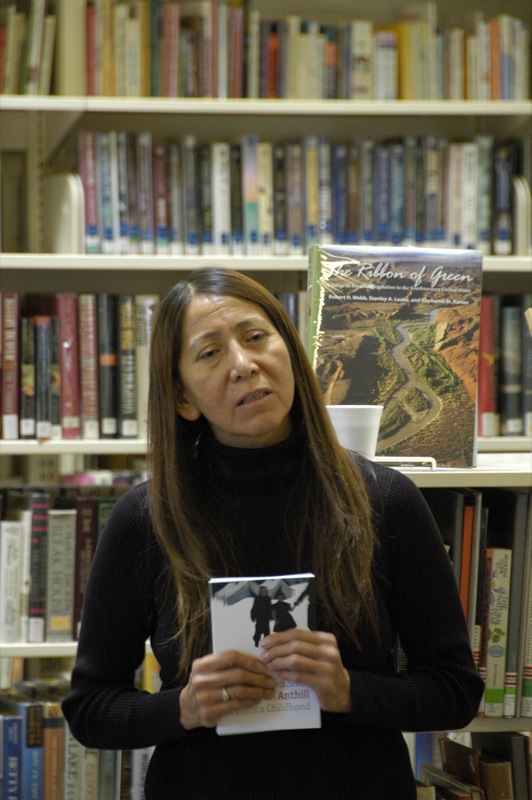
Delphine Red Shirt. Photo by Rich Luhr / Flickr
Lessons from history from a Lakota
By Delphine Red Shirt It is interesting how, after the Civil War, policy-makers faced two racial problems concerning African-Americans and American Indians: how to bring them into line with the rest of America. A solution, the government felt was to make them into farmers. But, the African-American had no land, even if he wanted to farm (“40 acres and a mule” policy); American Indians had the land but didn’t want to farm. At this time in history, the agents at Pine Ridge and the other reservations in South Dakota told the federal government that the Lakota and Dakota had no ambition to farm. The Lakota men were hunters and warriors and looked down on anything that had to do with laboring in the fields like the Wasitu farmers who worked hard on a land that didn’t produce much. The policy-makers didn’t listen to the agents who said the reservation lands were not suitable for farming, choosing instead to send out to Pine Ridge and the other reservations, farm implements, seeds and instructions to farm. In my own community, the “boss farmer” house is still located near the local store (old trading post) where 4-H meetings were held for elementary school children through the late 1960’s. By the late 1800’s, policy-makers realized that two other “occupations” better suited the Lakota and Dakota. One was cattle ranching as the reservation land that couldn’t sustain farming could support cattle ranching. For once, they acted right away and in 1879, the government sent 3,000 head of cattle to the reservations. The Lakota and Dakota men took real interest in cattle raising where the farm implements were often left to rust in the South Dakota sun, the men took good care of the stock. Three things happened to derail their success, first was the failure of the government to replenish the original herds of cattle with breeding stock. Secondly, the hard winters of 1886 and 1887 that would hit cattle ranching hard on the reservations as it did everywhere else in the northwestern United States. Finally the onset of World War I when the price of beef was so high that reservation cattle rancher sold most of their stock. The other “occupation” that Lakota and Dakota men took to was “freighting” or hauling annuity goods from the Missouri River to the Rosebud and Pine Ridge agencies in the 1880’s. One historian estimates that people at Pine Ridge were operating approximately 500 wagons, earning $40,000 hauling three million pounds of freight from Valentine, Nebraska to the Pine Ridge agency. By 1884, they expanded to carrying 100,000 pounds of goods to Wasitu merchants in the Black Hills. Eventually railroads expanded into those areas, but for a time, freighting was an economic endeavor that succeeded for the Lakota. This is a part of our history that needs to be remembered - what worked for our people at the beginnings of the end of the Lakota way of life as Crazy Horse, Red Cloud, and Sitting Bull knew it. As a Lakota scholar, history interests me because Lakota people saw history differently from the Wasitu - we were only interested in history as it relates to the present. How can it help us today? Cattle ranching worked for the people because we are a horse culture; freighting worked for us because it allowed us the freedom to travel as we once did, all across our homeland. An Indigenous scholar, Taiaiake Alfred believes that ultimately land claims, economic development, and legal recognition of our sovereign rights as nations are important. But there is no evidence that the “schemes” to implement them have done anything but benefited a minority of our people. These “schemes” create new bureaucracies and partnerships with non-Indigenous businesses. Alfred states that with all this “progress” going on, the fact is the majority of people on reservations receive no benefit. A case in point is what goes on, on our reservation at Pine Ridge. Alfred believes that the reason this happens across Indian lands, is because these “schemes” are still part of a colonizing structure that sees very little value in Indigenous or American Indian cultures. Instead, the colonial-based belief is that others know “what is best” for us. So, what worked in the past? Looking back on Lakota history, it seems cattle raising and freighting allowed us to remain true to our culture as a horse nation. These “occupations” were not foreign to us, perhaps even ingrained in us, our “blood memory.” The lesson that most Indigenous scholars learn, almost immediately, from scanning our own people’s histories is that culture is everything and until we turn assimilation around and return to our culture and language we will continue to be perceived and to perceive ourselves as a problem. (Delphine Red Shirt can be reached at redshirtphd@gmail.com) Copyright permission Native Sun News
Join the Conversation